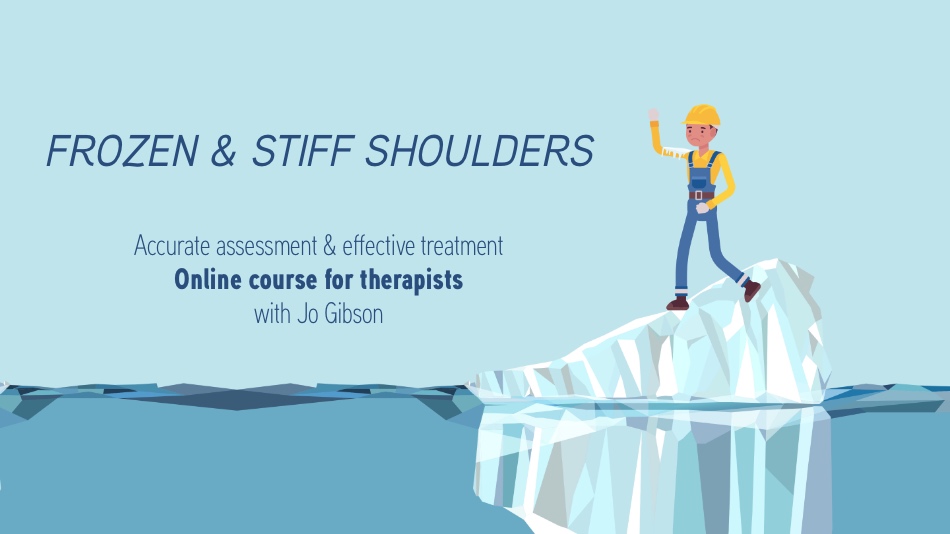
When is shoulder pain from the C/sp? When a patient presents with shoulder pain and stiffness, how can C/Sp referral be identified? If a patient has full neck range of movement, and neck movements don’t reproduce shoulder pain, can their pain still be from the C/sp?
Recent research shows that including treatment of the C/sp can improve results in up to ⅓ of shoulder pain patients. In this video with Jo Gibson (Clinical Physiotherapy Specialist) discover how to identify, assess and treat patients with cervical referral, including:
- What history and pain features will patients with cervical referred shoulder pain report?
- What assessment tests can be performed to diagnose or rule out the C/Sp involvement in shoulder pain?
- What information does palpation and repeated movements in the objective assessment provide?
- What does the research reveal about cervical referred shoulder pain?
- What biopsychosocial factors may be involved in cervical referred shoulder pain?
- How can manual therapy to the C/Sp improve shoulder range of movement?
- What education can be provided to patients with cervical spine referral?
- What exercises and exercise variations may be used to improve cervical referred shoulder pain?
- Are upper muscle fibres of trapezius “overactive” or are these muscles actually weak?
- What exercises can be used for upper traps in C/sp referred shoulder pain?
- What manual therapy can be used for C/sp referred shoulder pain?
- Does the thorax get “stiff”, and what exercises help improve thoracic range of movement?
Podcast handout
The handout for this podcast is articles referenced in the podcast. There is no additional transcript or handout available.
Free shoulder assessment infographic series
Frozen and stiff shoulder assessment & treatment with Jo Gibson
Shoulder: Steps to Success online course with Jo Gibson
Improve your assessment and treatment of shoulder pain with the Shoulder: Steps to Success online course with Jo Gibson, now available for enrolment at clinicaledge.co/shouldersuccess
Links associated with this episode:
- Improve your assessment and treatment of frozen and stiff shoulders now with Jo Gibson’s online course at clinicaledge.co/frozenshoulder
- Download and subscribe to the podcast on iTunes
- Download the podcast now using the best podcast app currently in existence - Overcast
- Listen to the podcast on Spotify
- Improve your confidence and clinical reasoning with a free trial Clinical Edge membership
- Let David know what you liked about this podcast on Twitter
- Review the podcast on iTunes
- Like the podcast on Facebook
- Infographics by Clinical Edge
- Jo Gibson on Twitter
Articles associated with this episode:
- Download the podcast handout to receive the articles associated with this podcast.
- Alonso-Perez JL, Lopez-Lopez A, La Touche R, Lerma-Lara S, Suarez E, Rojas J, Bishop MD, Villafañe JH, Fernández-Carnero J. Hypoalgesic effects of three different manual therapy techniques on cervical spine and psychological interaction: A randomized clinical trial. Journal of Bodywork and Movement Therapies. 2017 Oct 1;21(4):798-803.
- Hauswirth J, Ernst MJ, Preusser ML, Meichtry A, Kool J, Crawford RJ. Immediate effects of cervical unilateral anterior-posterior mobilisation on shoulder pain and impairment in post-operative arthroscopy patients. Journal of back and musculoskeletal rehabilitation. 2017 Jan 1;30(3):615-23.
- Katsuura Y, Bruce J, Taylor S, Gullota L, Kim HJ. Overlapping, Masquerading, and Causative Cervical Spine and Shoulder Pathology: A Systematic Review. Global Spine Journal. 2020 Apr;10(2):195-208.
- Vicenzino B, Collins D, Benson H, Wright A. An investigation of the interrelationship between manipulative therapy-induced hypoalgesia and sympathoexcitation. Journal of manipulative and physiological therapeutics. 1998 Sep 1;21(7):448-53.






